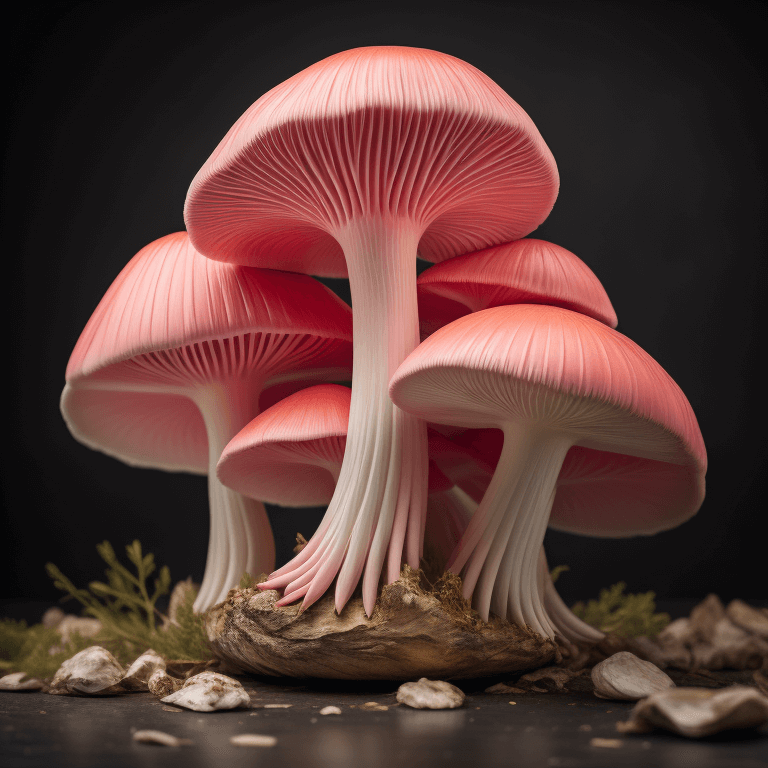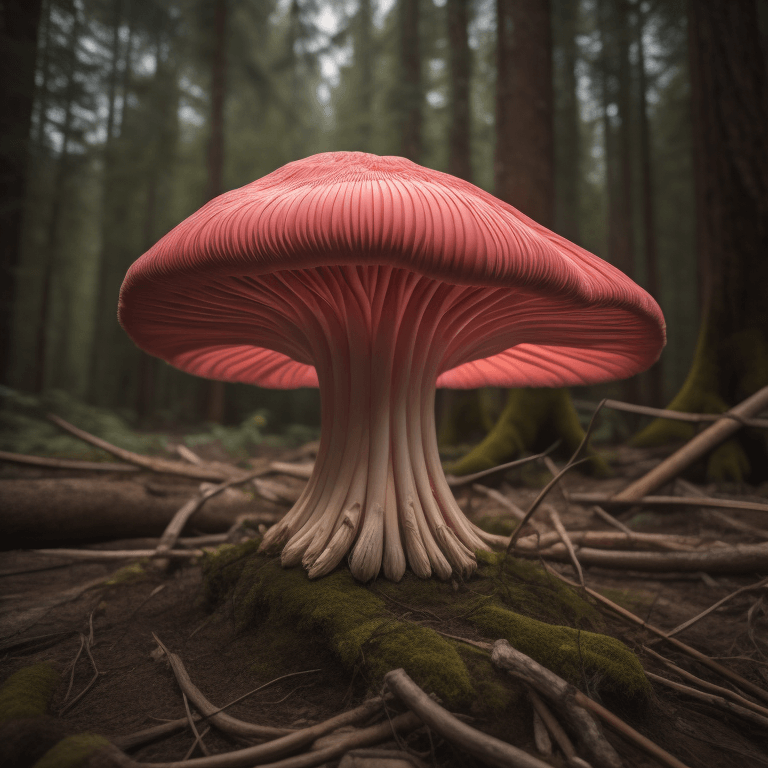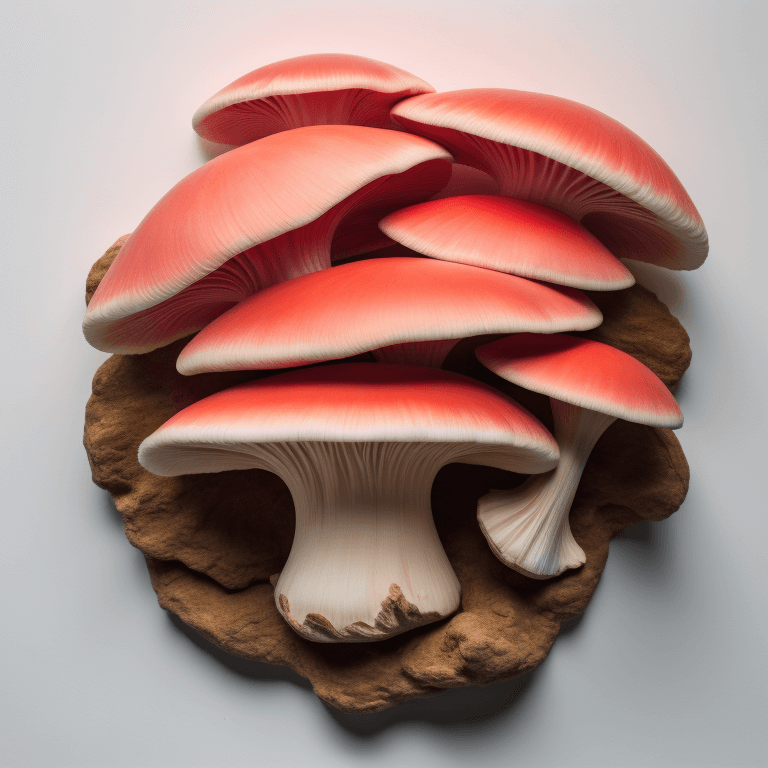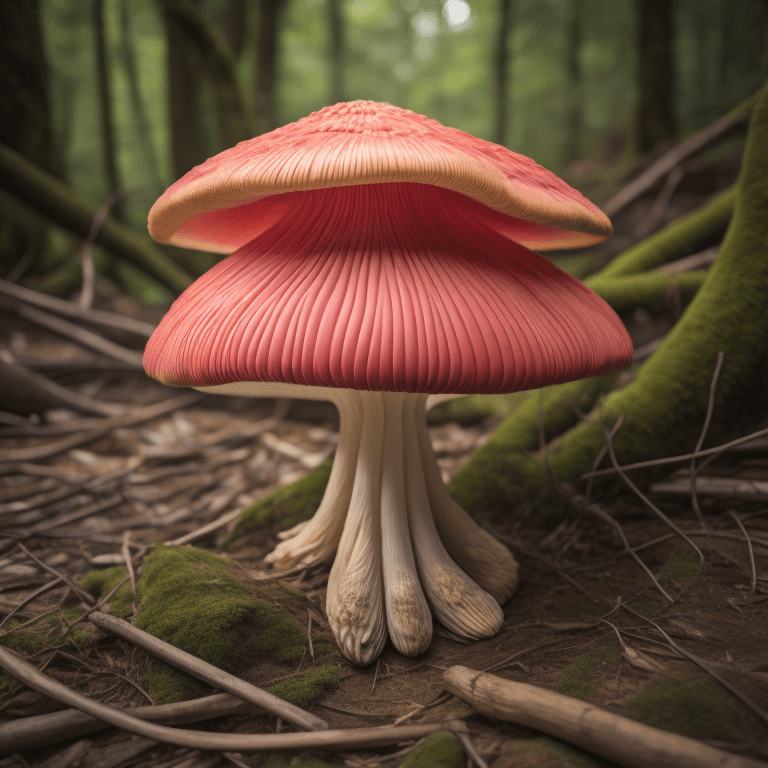The pink oyster mushroom (Pleurotus djamor) is a type of edible mushroom found in Southeast Asia.
It has a pinkish-white color and a slightly fruity taste.
This mushroom is often used in Asian cuisine and can be cooked or eaten raw.
It is also popular in Western countries, where it is used as an ingredient in dishes such as pizza and salads.

The pink oyster mushroom is a truly noteworthy species of fungus with color and texture, unlike any other mushroom.
But, beyond being aesthetically pleasing, the pink oyster mushroom also has some remarkable features that make it one of nature’s most intriguing organisms.
To start off, they have been found to purify water more effectively than many other fungi due to their ability to take up heavy metals from contaminated water.
They are also used as natural antibiotics and antivirals against many human pathogens due to their antibacterial properties and unique phytochemicals; this incredible effect makes them routinely sought after for medicinal purposes.
What is a pink oyster mushroom?
Pink oyster mushrooms are a unique species of fungi with a striking coloration that is found in maritime regions across North America and Europe, they have a bold pink hue that stands out among the other white or yellow fungi.
Explain it to a child
Pink oyster mushrooms are a type of fungi that is pink. They are found in maritime regions across North America and Europe.
Pink oyster mushrooms may be cooked or eaten raw, providing a robust earthy flavor with subtle notes of anise. They may also be dried and ground into a powder for use in soups, sauces, and other dishes.
What’s more, these unusual mushrooms contain many beneficial minerals and proteins which make them ideal for boosting nutrition while cooking.
What does a pink oyster mushroom look like?

- The pink oyster mushroom is a magnificent sight to behold. Its signature curved cap sports a brilliant pink hue made even more incredible against its white, finely-webbed gills. What gives these mushrooms their singular color is the species of fungus they belong to Pleurotus djamor.
- From afar, however, the entire entity may look like a pair of shells fittingly intertwined – another feature unique to Pleurotus djamor, who found them on decaying wood or straw logs in heavily shaded areas.
What does pink oyster mushroom taste like?
The pink oyster mushroom has a unique and distinctive flavor all its own. It has an earthy taste similar to shiitake mushrooms, but with a touch of sweetness as well.
When lightly cooked, the mushroom allows many different flavors to stand out and can be a refreshing addition to salads or entrees. More thorough cooking brings out the best flavors, offering hints of nutty, caramelized, and deep umami notes.
Pink oyster mushrooms shine when fried or added to stir-fries and curries. When adding them to your favorite dishes, you can look forward to a delightfully sweet and savory taste experience.
What does a pink oyster mushroom’s natural habitat?
The pink oyster mushroom is found in a variety of different habitats, ranging from wooded and grassy areas to even urban environments.

They can also be found in agricultural fields, along riverbanks, in meadows and clearings, around deciduous trees and gardens, or alongside fences, buildings, and roads.
Some species of pink oysters have been known to inhabit temperate hardwood forests, however, they generally prefer more moderate climates.
Their preferred environment includes dampness with lots of organic matter like leaves; they may also populate logs or dead wood but sometimes lack the presence of those resources.
The pink oyster mushroom may be difficult to find in its natural habitat as it usually grows in small clusters.
Where and when do pink oyster mushrooms grow?
Pink oyster mushrooms are a species of gilled fungi native to many parts of the world. Where and when they grow is reliant on their specific environment.
Generally speaking, pink oyster mushrooms like warm and humid climates where temperatures range from 59 to 77 degrees Fahrenheit.
They prefer environments with adequate sources of moisture, such as humid forests and grassy areas that experience frequent rain.
In the United States, pink oyster mushrooms are more commonly found in the Pacific Northwest particularly Oregon, Washington, and Alaska during the rainy months between August and November.
They can also be spotted in other greenbelt areas in North America and beyond.
How to grow pink oyster mushrooms by yourself?

Growing mushrooms at home can be a fun and rewarding experience. With pink oyster mushrooms, you can grow them easily by yourself in the comfort of your own home!
To start off the process, purchase a bag of mushroom spawn which will contain the mycelium (the vegetative part) that will produce the mushrooms.
Then find or create an ideal growing environment with conditions such as high humidity, temperatures between 60 to 85 degrees Fahrenheit, and plenty of indirect light.
Once you have these conditions in place, all you need to do is spread the spawn across your chosen substrate – such as straw or sawdust moisten it up and wait for your mushrooms to appear!
With patience and dedication, you’ll soon have fresh pink oyster mushrooms growing in no time!
How long do pink oyster mushrooms take to grow?
Growing pink oyster mushrooms is a relatively quick process, requiring just two to four weeks of preparation and cultivation.
The mushrooms thrive in the right mixture of moisture, light, sheltered environments, and nutrients.
During the growth cycle, farmers carefully monitor temperature and humidity levels to ensure ideal conditions for the mushrooms to develop.
Once achieved, these mushrooms can be harvested every two days over a period of up to three weeks before they turn brown and become unusable.
With proper care during their short lifespan, pink oyster mushrooms are a great edible choice for those looking for a fast homegrown staple crop that’s delicious and easy to prepare!
How does pink oyster mushroom harvest?
- Pink oyster mushrooms are a type of mushroom that grows abundantly in moist and humid habitats.
- As such, they can be harvested relatively easily compared to other types of mushrooms all that is required is a sharp knife and steady hands.
- When harvesting pink oyster mushrooms, the stem must be cut off right at the base without damaging the mushroom’s fruiting body.
- Once picked, these mushrooms should be refrigerated as soon as possible to prevent spoilage, and then consumed within a few days for optimal freshness and flavor.
How to clean pink oyster mushrooms?
Cleaning them properly is an important step to ensure the best quality of food.
- Start by brushing off any dirt or debris with a soft-bristled mushroom brush.
- Firmly hold the stem with one hand while using the brush with the other to gently remove any dirt from the cap.
- Rinse the mushrooms off briefly under cool, running tap water and place them on a kitchen paper towel to absorb any excess moisture before using.
This method ensures that your pink oyster mushrooms are clean and ready to be cooked up into a delicious dish!
How to preserve pink oyster mushrooms?
To preserve the mushrooms and extend their shelf life, they should be refrigerated at 36-40 degrees Fahrenheit and stored inside an airtight container or plastic bag.
To ensure optimal freshness, keep them away from direct light as this will cause them to dry out and spoil more quickly.
Additionally, it is best to use the mushrooms within two weeks after harvesting them and no later than four weeks of storage in the refrigerator.
Taking these steps will help ensure that pink oyster mushrooms stay fresh, flavorful, and safe to consume!
How to prepare pink oyster mushrooms?
Preparing pink oyster mushrooms is a relatively straightforward process. The first step is to pick out any spoiled or slimy mushrooms from the bunch.
Once you have clean mushrooms, they should be washed in cold water and patted dry with paper towels. If the stems are still attached, they should be cut off.
From here, you can either sauté them with a bit of oil, butter, and garlic to serve as a savory side dish, or you can use them in salads or other recipes for added flavor and texture.
In addition, the pink oyster mushroom can restore damaged soil by breaking down organic matter quickly and efficiently making it great for composting applications as well.
It is an edible variety commonly used in numerous dishes which gives it extra value as a sustainable food source farmers particularly appreciate its resilience since it can withstand harsh climates or conditions when compared to other mushroom types.
All in all, the pink oyster mushroom stands out among its peers thanks to the abundance of advantages associated with this fascinating species!
Article Sources
Jacks of Science sources the most authoritative, trustworthy, and highly recognized institutions for our article research. Learn more about our Editorial Teams process and diligence in verifying the accuracy of every article we publish.
